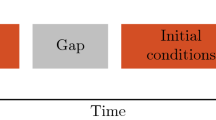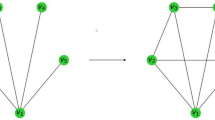Abstract
Hashkat (http://hashkat.org) is a free, open source, agent-based simulation software package designed to simulate large-scale online social networks (e.g., Twitter, Facebook, LinkedIn). It allows for dynamic agent generation, edge creation, and information propagation. The purpose of hashkat is to study the growth of online social networks and how information flows within them. Like real-life online social networks, hashkat incorporates user relationships, information diffusion, and trending topics. Hashkat was implemented in C++ and was designed with extensibility in mind. The software includes Bash and Python scripts for easy installation and usability. In this report, we describe all of the algorithms and features integrated into hashkat before moving on to example use cases. In general, hashkat can be used to understand the underlying topology of social networks, validate sampling methods of such networks, develop business strategy for advertising on online social networks, and test new features of an online social network before going into production.













Similar content being viewed by others
References
Albert R, Jeong H, Barabási AL (1999) Internet: diameter of the world-wide web. Nature 401(6749):130
Bastian M, Heymann S, Jacomy M et al (2009) Gephi: an open source software for exploring and manipulating networks. ICWSM 8:361
Brach P, Epasto A, Panconesi A, Sankowski P (2014) Spreading rumours without the network. In: Proceedings of the second ACM conference on online social networks (ACM), pp 107–118
Csardi G, Nepusz T (2006) The igraph software package for complex network research. InterJ Complex Syst 1695(5):1
de C Gatti MA, Appel AP, dos Santos CN, Pinhanez CS, Cavalin PR, Neto SB (2013) A simulation-based approach to analyze the information diffusion in microblogging online social network. In: 2013 winter simulations conference (WSC) (IEEE), pp 1685–1696
Doerr B, Fouz M, Friedrich T (2011) Social networks spread rumors in sublogarithmic time. In: Proceedings of the 43rd annual ACM symposium on theory of computing (ACM), pp 21–30
Erdös P, Rényi A (1959) On random graphs, I. Publ Math 6:290
Gleeson JP, Ward JA, O’sullivan KP, Lee WT (2014) Competition-induced criticality in a model of meme popularity. Phys Rev Lett 112(4):048701
Hagberg A, Schult D, Swart P, Conway D, Séguin-Charbonneau L, Ellison C, Edwards B, Torrents J (2013) Networkx. High productivity software for complex networks. Webová strá nka. https://networkx.github.io. Accessed 2 Feb 2017
Java A, Song X, Finin T, Tseng B (2007) Why we twitter: understanding microblogging usage and communities. In: Proceedings of the 9th WebKDD and 1st SNA-KDD 2007 workshop on Web mining and social network analysis (ACM), pp 56–65
Klügl F, Puppe F (1998) The multi-agent simulation environment sesam. In: Proceedings des workshops simulation in knowledge-based systems, vol tr-ri-98-194 of Reihe Informatik, Paderborn (Citeseer)
Li X, Mao W, Zeng D, Wang FY (2008) Agent-based social simulation and modeling in social computing. In: International conference on intelligence and security informatics. Springer, Berlin, pp 401–412
Mislove A, Marcon M, Gummadi KP, Druschel P, Bhattacharjee B (2007) Measurement and analysis of online social networks. In: Proceedings of the 7th ACM SIGCOMM conference on internet measurement (ACM), pp 29–42
Myers SA, Leskovec J (2014) The bursty dynamics of the twitter information network. In: Proceedings of the 23rd international conference on world wide web (ACM), pp 913–924
Pastor-Satorras R, Castellano C, Van Mieghem P, Vespignani A (2015) Epidemic processes in complex networks. Rev Mod Phys 87(3):925
Schulze TP (2008) Efficient kinetic Monte Carlo simulation. J Comput Phys 227(4):2455
Silverstein C (2010) Google sparsehash package. https://github.com/sparsehash/sparsehash. Accessed 2 Feb 2017
Stadtfeld C (2013) NetSim: a social networks simulation tool in R. http://www.christoph-stadtfeld.com/netsim/. Accessed 2 Feb 2017
Ugander J, Karrer B, Backstrom L, Marlow C (2011) The anatomy of the facebook social graph. arXiv preprint arXiv:1111.4503
Voter AF (2007) Introduction to the kinetic Monte Carlo method. In: Sickafus KE, Kotomin EA, Uberuaga BP (eds) Radiation effects in solids. Springer, Berlin, pp 1–23
Wolfram S et al (1986) Theory and applications of cellular automata, vol 1. World Scientific, Singapore
Zeng R, Sheng QZ, Yao L (2015) A simulation method for social networks. Soc Netw Anal Min 5(1):1. doi:10.1007/s13278-015-0246-4
Acknowledgements
The authors would like to thank the National Sciences and Engineering Research Council of Canada (NSERC) for funding as well as Compute Canada for computational resources.
Author information
Authors and Affiliations
Corresponding author
Rights and permissions
About this article
Cite this article
Ryczko, K., Domurad, A., Buhagiar, N. et al. Hashkat: large-scale simulations of online social networks. Soc. Netw. Anal. Min. 7, 4 (2017). https://doi.org/10.1007/s13278-017-0424-7
Received:
Revised:
Accepted:
Published:
DOI: https://doi.org/10.1007/s13278-017-0424-7




